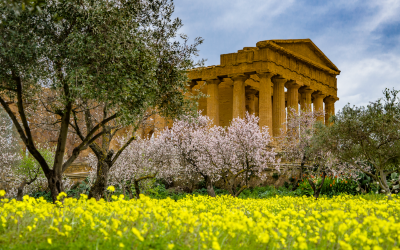The Steri is one of the symbolic places of the city of Palermo. It contains, in fact, seven centuries of history!
-
Opening times
Open every day with visits accompanied by a specialized operator
- from 1 March to 31 October from 9:00 to 20:00 last admission at 19:00
- from 1 November to 28 February from 9:00 to 18:00 last admission at 17:00
-
Closing
October 25 and 31, 2023,
closing at 2.00pm, last entry at 1.00pm - Web Steri - Palazzo Chiaromonte
-
Feature List
- Wheelchair accessible
- Downloadable Audioguide
-
Accessibility
Partially accessible to people with reduced mobility
BACKGROUND
The construction of the building started in the first half of the 14th century, thanks to Giovanni Chiaromonte, and was the house of Manfredi I, count of the immense and powerful fief of Modica.
The place of construction, the Kalsa district, was chosen for its proximity to the sea and the quality of the building ground: a rocky ridge nearby the port, in front of the bay covered by marshes where Piazza Marina stands today. The noble family reached its apogee with Manfredi III, admiral, vicar and duke of Gerba, who commissioned the extraordinary wooden ceiling of the Sala Magna in the Seventies and Eighties of the 14th century, a true medieval jewel, restored and brought to light again at the end of 2019, just before the outbreak of the pandemic.
The Chiaromonte dinasty did not last long: after the arrival in Sicily of King Martin the Younger, his father Martino the Elder and Queen Maria, the family was overthrown and in 1392 Andrea Chiaromonte was accused of treason and beheaded. This is the end of the dynasty and Enrico Chiaromonte left Sicily forever in 1397.
The residence is designed as a majestic cube with three elevations (the last of which remained unfinished) with a central square courtyard surrounded by a two-level exterior gallery.
After the confiscation of Chiaromonte’s assets, the palace became the viceregal seat between 1468 and 1517 and assigned to new institutional functions after. In the following centuries, between 1601 and 1782, the palace was the seat of the Spanish Inquisition, during which prisons and torture cells on the lower floor were built - a real “scream of pain” that is now included in the tour -; then it became the seat of the Customs’ Headquarters, of the Courts of the Kingdom, until it was acquired in 1967 by the University of Palermo which in 1972 entrusted the restoration to a team of architects [Roberto Calandra, Camillo Filangeri, Nino Vicari] under the supervision of Carlo Scarpa, until 1978 (year of his death).
He managed to carry out a modern, conservative recovery, which only included materials compatible with the historical era and ingenious solutions aiming at healing the damages caused by previous interventions. It is the Steri as we know it now.
LA VUCCIRIA BY RENATO GUTTUSO
"The painting is a synthesis of objective and definable elements, things and people: a large still life crossed by a narrow tunnel where people flow and meet. And above all, it is a sign of gratitude, with all my might, for the great debt I owe to my city." Renato Guttuso
Renato Guttuso painted La Vucciria between October 1st and November 6th, 1974. At the time, Guttuso was 63 years old, lived in Velate and had the need to keep alive the memory of all those good things displayed at the market. Most of those goods could not be found in the Lombard markets: his faithful caretaker Isidoro was thus instructed to put some “robba” (=stuff) on the first available flight to Milan, and from Malpensa it was then immediately sent to the studio. Stories and memories of Fabio Carapezza Guttuso: La Vucciria really seems to have been born among alleys and dripping boxes, on a particular black background from which the images emerge.
It is a large square canvas, 3 m x 3 m, whose view develops vertically and focuses the attention on different focal points: the characters, the tidy goods, the highlighted details.
On the top, the orange and red of meats, sausages and fruit displayed inside the crates are predominant. In the central and lower parts, the colors become lighter; on the left the white, gray and blue of the fish caught, on the right the light green and yellow of the vegetables, while the white of the eggs recalls the woman's dress.
La Vucciria is certainly the canvas of Palermo, adopted by the city since its birth, causing a war between institutions for its purchase, with burning letters between the Municipality and the Region. Finally, it was Renato Guttuso himself who decided to give it to the University and to exhibit it at the Steri.
Services
-
Visits
scheduled for individuals
available in Italian -
Visits
for groups by reservation tour@coopculture.it
available in Italian, English -
Didactics for schools
by reservation edu@coopculture.it
available in Italian, English
Where
Piazza Marina, 59 - Palermo
Transportation
BUS
from the Central Station lines 103 and 107

















